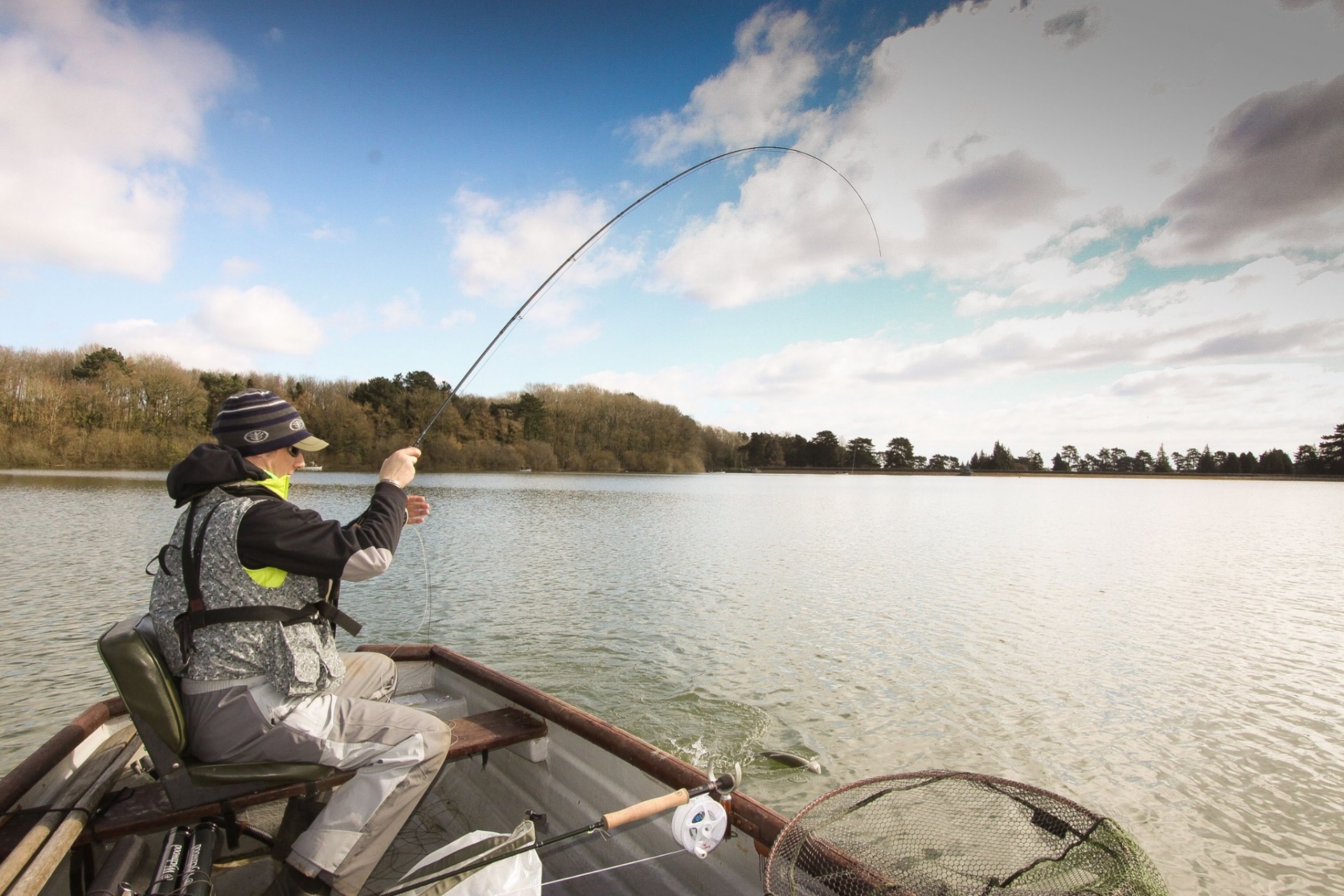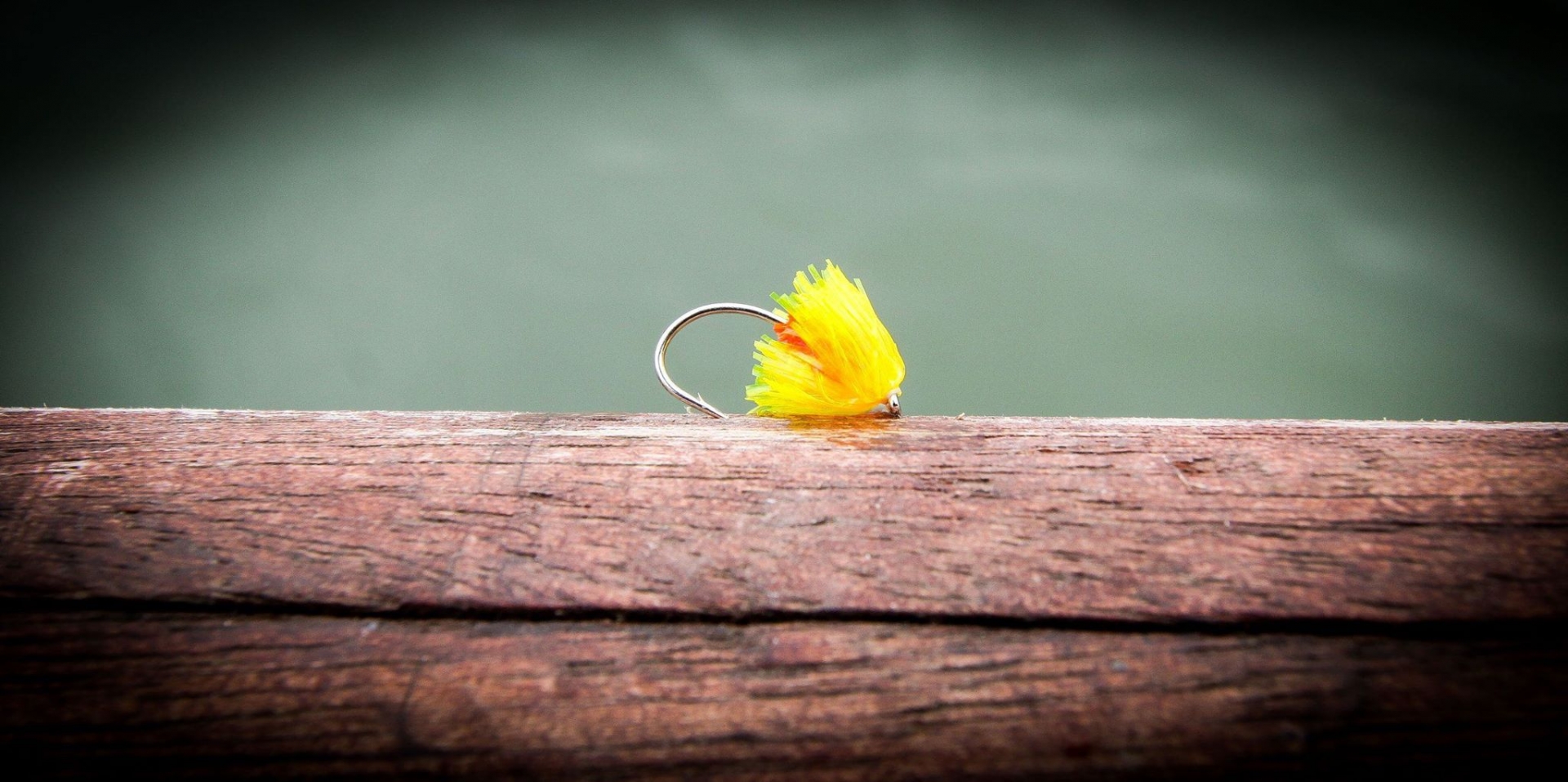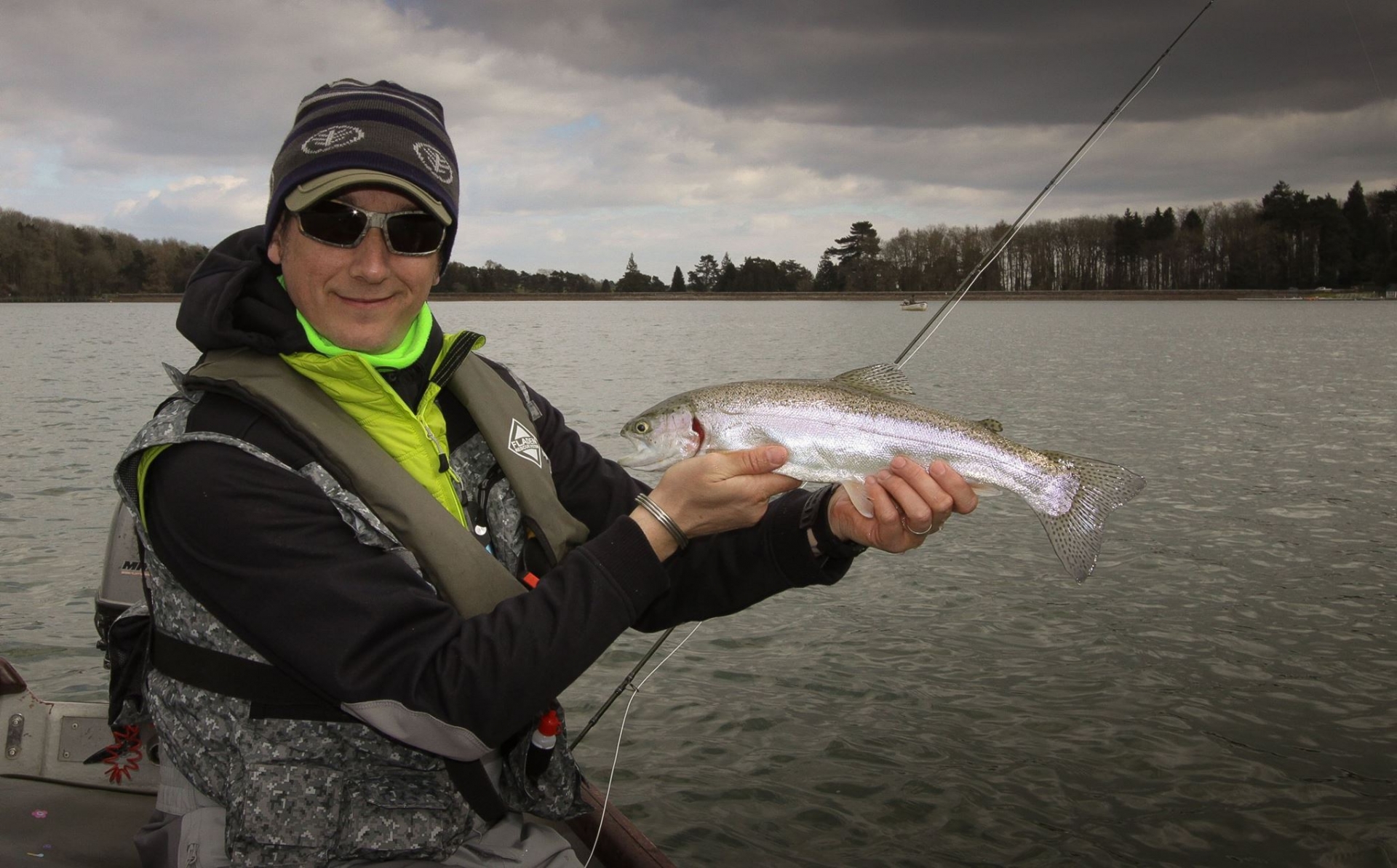Getting things to fall into place early on in the season when, you’re out afloat in a boat is not as hard as some would have you believe…
There are no secret flies or special lines that one must have in order to succeed, in fact, far from it, ‘keep it simple stupid’ and you won’t go far wrong!
When afloat there are two ways to go, you can anchor or you can drift. Okay I’m assuming I’m preaching to the converted here, but if you don’t know the differences between anchoring and drifting, message me.
In short, anchoring is parking the boat, by heaving an anchor over the side and letting it settle into the mud. Fishing from an anchored boat is a great way of presenting your flies all the way through the water column and with the utmost of ease, you can fish the flies with everything from a floating line to a fast sinker. Simply, park the boat and cover the water in front of you, dead easy.
Anchoring Pros
• Fish at a sedate manner
• Cover the water column effectively from top to bottom
• You can stay on top of the fish all day long – if they don’t move.
Anchoring Cons
• You can’t cover fresh water all the time without lifting and dropping the anchor.
• If the fish move, you catch nothing!
• You tend to wind up all those other anglers that choose to drift.
 Drifting on the other hand is where you fish out the front of the boat with the wind pushing you along from behind. Depending on the strength of the wind you may need to go to a super-fast sinking line in order to get your choses flies down to the fish. You can however slow the drift down with a drogue, again if you don’t know what this is again, message me, but it’s a kind of underwater parachute.
Drifting on the other hand is where you fish out the front of the boat with the wind pushing you along from behind. Depending on the strength of the wind you may need to go to a super-fast sinking line in order to get your choses flies down to the fish. You can however slow the drift down with a drogue, again if you don’t know what this is again, message me, but it’s a kind of underwater parachute.
Drifting Pros
• Cover fresh water all the time
• You allow other drifting anglers a chance at catching fish too.
• It’s easy to start the motor and head elsewhere fast if you’re not catching
Drifting Cons
• Being obstructed by anchored boats
• It may be difficult to get back over feeding fish if another boat is following your drift.
• If the wind is too strong, your flies may not get down to fish feeding deep.
I much prefer to fish form a drifting boat the whole year through.
To drift effectively I use a drogue not just to slow the boat down but also to stabilise the drift and keep the boat heading in the right direction. Direction can be tweaked, if you use a ‘sliding’ drogue, again message me, if it’s went over your head! This way you can cover all the intricate contours of the bank with ease.
Where
Early doors, I look for water that is between 5ft and 15ft deep, water deeper than this will have very little in the way of feeding fish, so try if you can, to stick to a drift that takes you onto the shore rather than away from it.
I like to start my drifts 100-yards out from the bank, in a steady wind this gives you about 15 to 20 minutes fishing time, more than enough to find out if there are feeding trout in the area, if not do the same again but this time 50 yards further along the bank. Keep doing this until you find taking fish, once you do it’s a case of honing your tactics in order to capitalise!
What With
Line choice, to start with for me anyway is always with a medium sink line. I can fish it fast and keep my flies high in the water or, if I wish, retrieve it slowly, letting the flies get down deep toward the lakebed.
As for flies, don’t get the wool pulled over your eyes, you need nothing fancy at this time of year, not at all. Lures, everything from Blobs, I can’t see past ones tied with sunburst or black fritz, to long marabou tailed lures like Concrete Bowls and Cat’s Whiskers, these are going to do a great deal of damage.
When you do find trout, it may be worth your while to fish over them with buzzers, sport may not be as hectic but it can be a great deal more satisfying, try black ones tied on size 10 hooks. Use straight hooks for droppers and a grub hook on the point, I feel grub hooks tied on droppers are a recipe for tangles!
How
It’s funny, I watch these guys out on boats retrieving their flies at a furious rate of knots, please, if you want to enjoy your day and catch more fish into the bargain then slow everything right down. The water is still cold and the fish will be a little lethargic to say the least, they don’t want to be hurtling after flies that are being fished back at brake neck speed.
Please, snail’s pace.
So that’s the basics, bare minimum basics, but when you find fish you may have to adapt. Fishing situations change fast and you may need to alter your approach to make the most of things….
Raventhorpe Reservoir
A good example of this need to change, was recent day on Ravensthorpe Water, part of the four Anglian Water venues, with a good mate, Jim Foster.
We’d both been on the water in the last few weeks so we knew that it could be good, if not downright easy at times, so, we were eager beavers!
The weather was spot on, a light breeze, high skies and the occasional cloud cover, lovely. Jim, who’d not long gotten back into fly tying was determined to try his buzzers, black ones with green holographic rib, simple flies. He set up three of these, three feet apart under the bung. Three size 10 buzzers, a fly throughout the water column, easy peasy.
I on the other hand wanted to find fish, rather than wait for things to happen, and the way to do this is to get down to them with lures.
I chose to fish the Deck Zone line, and a long leader, 8ft to a Blob and then a further 10ft to a FAB version of the same fly. I can fish one deep and on the deck and point fly higher in the water can be easy seen from below… fish’s eyes are near the top of their heads folks, bear that in mind.
All the boast were anchored up near the little walkway in the top corner of the dam, but we chose to drift, and we kept well away from the other boats, starting on the west side of the island in shallow water and drifting out 200 yards past the small scrap of land.
We both found nothing in the shallows, but started to hit fish 100 yards past the island, both of us taking fish within a few cast of each other, Jim on the 9ft buzzer and me on the Blob on the dropper. These were stockies that had seen some pressure. How can I tell, I hear you ask?
Rather than everything locking up for me on the lures or the bung burying deep for Jim, the takes were, ‘rattly’. Not the arm wrenches’ we were expecting, in fact, amazingly for this time of year, the takes out numbered fish in the net.
I quickly shortened the length of line to the Blob on the dropper by about 4ft, this meant that I was often pulling this fly through weed. It didn’t matter this little change meant that the trout were now nailing the FAB wafting above them with gusto, a minor adjustment but one that paid off big time with five trout in the boat in as many casts.
The taking point - and if you study what you’re doing you’ll find a taking point too - was when the weight of the heavy line came off the bottom, the change of angle, as the fly came off the bottom and started to rise was the time to pay attention.
Sadly, as often happens our fish catching action started to attract other boats, other boats that waited until you went back to do the top of the drift and then dropped their anchor over where you were catching the feeding fish!
Frustrating to say the least.

So we moved away from the area and went to the other side of the reservoir, it was colder and bumpier with the wind blowing onto it but he who dares Rodney!
Within a few casts of starting the drift I had a thumping take just as the flies hit the water. The fight was far better than the other ones that I’d had from fish I’d caught that morning, could it be a BIGGY?
It took a while before I saw the fish but when I did, it was not the biggy I’d thought it was, nope it was a thin, streamlined torpedo of a trout, an overwintered one, with a razor sharp tail, no wonder it pulled so hard!
It was all of 2lb but just what a rainbow should look like, a page three pin up!
Once I’d dispatched this beauty, my neighbour’s do great smoked trout, I swapped over to a floating line, the fish was high in the water remember. Jim took one too, another skinny beauty, this one a little too thin, like an eel, but same again, what a scrap it gave him. This one too was high up in the water, on the top dropper, which was now only a couple of feet under the bung due to a ‘cut off and retie tangle’ Jim had had earlier.
With the floater threaded up through a softer rod, a 10ft 7-wt T2. I attached two Cormorants on 6lb fluorocarbon, at 6ft intervals, again, very simple fishing.
To fish this effectively I cast to the side of the boat rather than in front, I like the angle that’s created and I can watch the loop of line from the rod tip to the water’s surface like a hawk for any super subtle takes.
Before we got to the bank we heard an anchor going over the side of a boat behind us… SERIOUSLY!
We finished the drift and went back, this time fishing off to the side of the chaps that took it upon themselves to anchor in the middle of where we wanted to drift!
Jim never had another take in the next hour or so, but I was pulling into fish every 4th or 5th cast a mixture of stockies and good, well-mended trout.
After a while, with no success, Jim switched over to dries, a Big Red and a Hopper and to be fair I could see why, as I had covered two fish in the last drift that appeared to be coming up for some small midge on the surface, proper risers in early March! Jees it’s been a mild winter.
As he went ‘fully committed’ on the dries, I felt I had to do the same, but not with the same flies as him, oh no, those are summer flies. I snipped off the dropper and trimmed the tippet down to 8ft, yes, you saw that right 8ft. The water was carrying a touch of colour and these fish hadn’t really been fished for yet.
On the end went a size 16 shuttlecock, so, short leader, single fly, equals pinpoint presentation…
Long story short, and I’m sure all of you will sympathise with this, after seeing fish move on the last drift, the next two drifts proved utterly futile, not one rise, bugger all!
“One more drift for luck Jim” I asked, “Yeah, why not?” he said.
50-yards down the drift, one rose, it was at my side of the boat 25ft away. I lifted my line off the water and covered the fish in one swift movement. Within two seconds of it rising I’d put the fly a coupler of foot upwind of it.
The fish came up, my fly disappeared and I lifted the rod tip and felt instant pressure, as I raised the rod, the trout leapt clear of the water, a shower of spray and glint of polished silver as it’ flanks caught the watery spring sun and then.. my line went limp. He was off, damn! Oh well..
Four methods in a the same amount of hours and we covered the water from bottom to top, we’d caught on the deck and nearly off the top, stockies in numbers and a handful of overwintered beauties. In truth, not bad going for a few hours in early March, I can’t wait for the season proper now.


